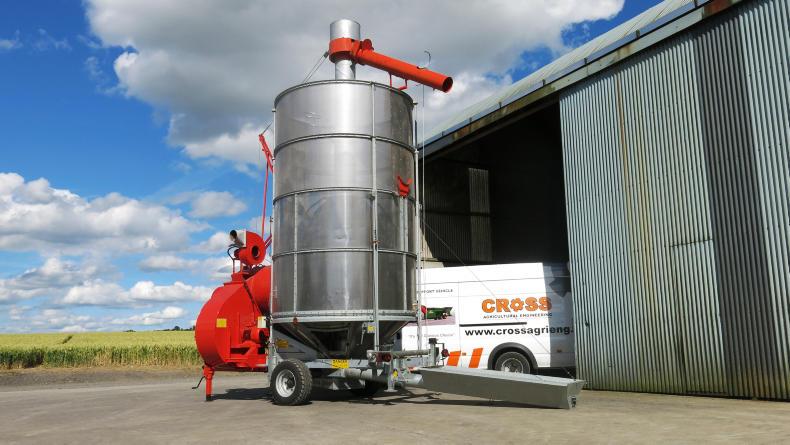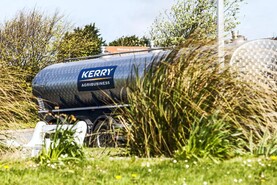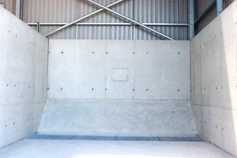The new tillage capital investment scheme covers both batch and continuous-flow grain drying equipment. Tom McHugh, grain drying specialist from Two Mile House, Co Kildare, expects batch systems to be more popular than continuous-flow dryers in the scheme. “I expect tower-type mobile batch systems to be the most popular option in terms of grain drying, because they are suitably sized for the average Irish tillage farmer and they are more affordable,” explained Tom.
A batch system can be loaded with a power shovel or some systems can load themselves automatically, with a set amount of grain. During drying, the system is constantly recirculating grain and cleaning at the same time.
Once grain is brought down to the required moisture level, the system can cool and unload the grain itself. He says a 25t to 27t batch dryer costs approximately €65,000 to €72,000, excluding VAT. “This type of batch system is capable of filling, drying, cooling and emptying a 25t batch of grain in three to four hours,” said Tom.
He said larger farmers, farming over 1,000 acres might consider a continuous-flow dryer. “These dryers have a greater output, because they can work constantly but are a more costly option,” he explained.
A dryer with a 25t to 30t/hour capacity – which is a medium-size working plant – with necessary extras such as an intake, cleaner, off-take elevator and an elevator for the store would cost €130,000 to €155,000 excluding VAT, according to Tom.
Department specifications
The Department of Agriculture has set out specifications for grain dryers for the TAMS II. They say all batch and continuous-flow grain driers must be of proprietary (branded) manufacture.
The grain driers must have integral intake and discharge augers.
Grain driers must be fitted with an integral grain cleaning and dust catchment system. It is important that only the most minimal amount of dust can enter the air intake system of the grain drier.
The driers must be electronically controlled and be capable of monitoring the grain temperature and grain moisture. The driers may be either direct fired – where the flue gasses pass through the grain – or indirect fired.
Indirect-fired grain driers must be fitted with a heat exchanger, and the flue gasses expelled away from the grain drying area.
Reference costs:
All items covered under TAMS II have reference costs. The reference cost should reflect the total cost of an investment. Some of the costs are displayed as formulas. This is to allow for the calculation of costs for different-size equipment.
The grant aid calculation is based on the lowest of either the Department’s reference cost, the proposed cost by an applicant at the application stage or receipts per finished investment item. Below we have shown the reference costs for both batch and continuous- flow drying systems.
Batch
Equation to calculate the reference cost for a batch, direct heat grain dryer: y = 1,203.8x + 36,284.Equation to calculate the reference cost for a batch, indirect grain dryer:
y = 1,316.5x + 43,481.Both direct and indirect-fired batch grain driers are costed based on the capacity, in metres cubed (m3), that the drier can dry in one batch.
The cost is calculated by use of the relevant equation given, where x= capacity, in m3, of the drier and y = the cost of the drier.
For example, if the proposed direct-fired drier has a capacity of 10m3, to get the cost of the direct-fired drier, multiply 10 by 1203.8 and then add 36,284. This gives a cost of €48,322 for the direct-fired drier.
Continuous flow
Equation to calculate the reference cost for a continuous flow, direct heat grain dryer: y = 1,826.9x + 71,067.
Equation to calculate the reference cost for a continuous flow grain, indirect heat dryer grain dryer: y = 1,826.9x + 72,967.
Both direct and indirect-fired continuous-flow grain driers are costed based on the capacity, in tonnes per hour, that the drier can dry in one hour. The cost is calculated by use of the relevant equation given, where x = capacity, in tonnes per hour, of the drier and y = the cost of the drier.
For example, if the proposed direct-fired continuous-flow grain drier has
a capacity of 60t per hour, to get the cost of the direct-fired continuous-flow
drier multiply 60 by 1,826.9 and then
add 71,067. This gives a cost of €180,681.00 for the direct-fired continuous-flow
drier.
Read more
Special focus: TAMS for tillage
The new tillage capital investment scheme covers both batch and continuous-flow grain drying equipment. Tom McHugh, grain drying specialist from Two Mile House, Co Kildare, expects batch systems to be more popular than continuous-flow dryers in the scheme. “I expect tower-type mobile batch systems to be the most popular option in terms of grain drying, because they are suitably sized for the average Irish tillage farmer and they are more affordable,” explained Tom.
A batch system can be loaded with a power shovel or some systems can load themselves automatically, with a set amount of grain. During drying, the system is constantly recirculating grain and cleaning at the same time.
Once grain is brought down to the required moisture level, the system can cool and unload the grain itself. He says a 25t to 27t batch dryer costs approximately €65,000 to €72,000, excluding VAT. “This type of batch system is capable of filling, drying, cooling and emptying a 25t batch of grain in three to four hours,” said Tom.
He said larger farmers, farming over 1,000 acres might consider a continuous-flow dryer. “These dryers have a greater output, because they can work constantly but are a more costly option,” he explained.
A dryer with a 25t to 30t/hour capacity – which is a medium-size working plant – with necessary extras such as an intake, cleaner, off-take elevator and an elevator for the store would cost €130,000 to €155,000 excluding VAT, according to Tom.
Department specifications
The Department of Agriculture has set out specifications for grain dryers for the TAMS II. They say all batch and continuous-flow grain driers must be of proprietary (branded) manufacture.
The grain driers must have integral intake and discharge augers.
Grain driers must be fitted with an integral grain cleaning and dust catchment system. It is important that only the most minimal amount of dust can enter the air intake system of the grain drier.
The driers must be electronically controlled and be capable of monitoring the grain temperature and grain moisture. The driers may be either direct fired – where the flue gasses pass through the grain – or indirect fired.
Indirect-fired grain driers must be fitted with a heat exchanger, and the flue gasses expelled away from the grain drying area.
Reference costs:
All items covered under TAMS II have reference costs. The reference cost should reflect the total cost of an investment. Some of the costs are displayed as formulas. This is to allow for the calculation of costs for different-size equipment.
The grant aid calculation is based on the lowest of either the Department’s reference cost, the proposed cost by an applicant at the application stage or receipts per finished investment item. Below we have shown the reference costs for both batch and continuous- flow drying systems.
Batch
Equation to calculate the reference cost for a batch, direct heat grain dryer: y = 1,203.8x + 36,284.Equation to calculate the reference cost for a batch, indirect grain dryer:
y = 1,316.5x + 43,481.Both direct and indirect-fired batch grain driers are costed based on the capacity, in metres cubed (m3), that the drier can dry in one batch.
The cost is calculated by use of the relevant equation given, where x= capacity, in m3, of the drier and y = the cost of the drier.
For example, if the proposed direct-fired drier has a capacity of 10m3, to get the cost of the direct-fired drier, multiply 10 by 1203.8 and then add 36,284. This gives a cost of €48,322 for the direct-fired drier.
Continuous flow
Equation to calculate the reference cost for a continuous flow, direct heat grain dryer: y = 1,826.9x + 71,067.
Equation to calculate the reference cost for a continuous flow grain, indirect heat dryer grain dryer: y = 1,826.9x + 72,967.
Both direct and indirect-fired continuous-flow grain driers are costed based on the capacity, in tonnes per hour, that the drier can dry in one hour. The cost is calculated by use of the relevant equation given, where x = capacity, in tonnes per hour, of the drier and y = the cost of the drier.
For example, if the proposed direct-fired continuous-flow grain drier has
a capacity of 60t per hour, to get the cost of the direct-fired continuous-flow
drier multiply 60 by 1,826.9 and then
add 71,067. This gives a cost of €180,681.00 for the direct-fired continuous-flow
drier.
Read more
Special focus: TAMS for tillage






 This is a subscriber-only article
This is a subscriber-only article











SHARING OPTIONS: